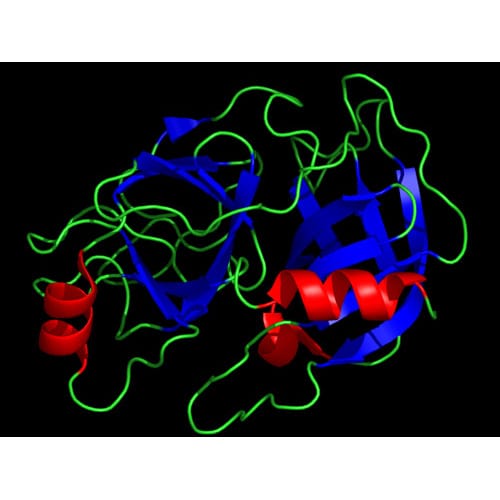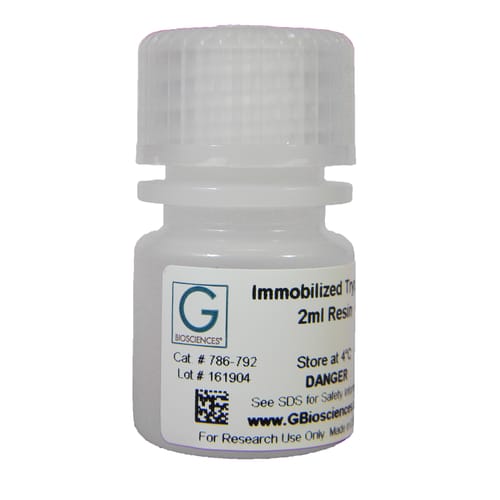The Roles of Trypsin in Protein Analysis
What is Trypsin?
 Occurring naturally in the small intestines of vertebrates, trypsin breaks down proteins as a component of the digestive process. Initially, it is in the pancreas as trypsinogen before conversion to the active trypsin state by the enzyme enteropeptidase via proteolytic cleavage. Trypsin then interacts with pepsin and chymotrypsin to separate proteins into peptides and amino acids. Thus, this enzyme has been historically utilized and respected as a handy tool for protein analysis. The molecular weight of trypsin sits at 23.3 kDa from bovine and porcine (pig) sources, and the ideal pH anywhere between 7.5 and 8.5.
Occurring naturally in the small intestines of vertebrates, trypsin breaks down proteins as a component of the digestive process. Initially, it is in the pancreas as trypsinogen before conversion to the active trypsin state by the enzyme enteropeptidase via proteolytic cleavage. Trypsin then interacts with pepsin and chymotrypsin to separate proteins into peptides and amino acids. Thus, this enzyme has been historically utilized and respected as a handy tool for protein analysis. The molecular weight of trypsin sits at 23.3 kDa from bovine and porcine (pig) sources, and the ideal pH anywhere between 7.5 and 8.5.
What Are the Uses for Trypsin?
Typically, this versatile enzyme is utilized in cell and tissue development as well as peptide sequencing techniques for protein identification. Researchers also find trypsin particularly useful for dissolving blood clots, treating inflammation, and dissociating dissected cells before fixing and sorting.
The Two Main Limitations of Trypsin
Incomplete digestion proves to be a limiting factor of trypsin in research. Trypsin tends to leave behind between 10% and 30% undigested sites, especially lysine sites, and to avoid this issue, many researchers supplement with Lysine-C. Affects includes enhanced performance that does not interfere with the structure of digestion products.
Natively, this enzyme is prone to trypsin autolysis – Trypsin’s second main limitation. When lysed, the new state is best described as a pseudo-trypsin that exhibits broader, less specific proteolytic capabilities and produces trypsin fragments that are invasive to sequence analysis. In order to avoid autolysis, researchers chemically methylate trypsin to create an enzymatically active protein. This protein exhibits maximum specificity and is highly resistant to the aforementioned undesirable process.
Immobilized Trypsin for Protein Mass Spectrometry Sample Preparation
Mass Spectrometry: An Important Tool for Proteomics
Mass spectrometry is used for several proteomic measures, including:
- Relative quantitative proteomics
- Identification of protein binding partners
- Signal transduction pathways
- Protein post translational modifications
- Characterizing purified protein samples
- Discovering biomarkers
Defining Immobilized Trypsin
TPCK treated trypsin, immobilized on 4% agarose, eliminates contamination of protein digests, and is known to researchers as immobilized trypsin. Natural trypsin cleaves peptide bonds on the carboxy side of s-aminoethyl cysteine, arginine, and lysine residues. Generally, there is minimal cleavage at arginyl-proline and lysyl-proline bonds. Because of the distribution of these residues in proteins, trypsin is a serious aid in spectrometry protein identification through digestion that produces peptides. That being said, when lysine and arginine are followed by nonpolar proline, aspartic acids, or glutamic acids, the digestion is less efficient.
Some common uses include:
- Protein identification
- Quantitative analysis
- Differential expression
- Post-translational modifications
Immobilized Trypsin in Mass Spectrometry
Immobilized trypsin is a quick, efficient tool for digesting several concentrations of purified protein and complex mixtures. Separation of the immobilized trypsin and newly digested peptides is a breeze thanks to their flow through spin columns into collection tubes (the trypsin will not pass through the column). These digestions can all occur in the space of 30 minutes, which is an important factor that makes this enzyme so widely used.
Rely on G-BioSciences for Your Trypsin Needs
G-Biosciences offers a variety of trypsin products for your experiments. To learn more, visit our website and place an order today.






